SS New
Please Note: Firefox and some other Search Engines may not be suitable
Use Google Chrome for this Web Page to load perfectly!
Please Note: All ssMaritime and other related maritime
sites are 100% non-commercial and privately owned, thus ssmaritime is NOT
associated with any shipping company or any other organisation! Although the
author has worked and been involved in the passenger shipping industry for well
over 60 years, but due to his old age and poor health, he was forced to retire.
Yet, he has completed well over 1,360 Classic Liners, Passenger-Cargo Liners as
well as humble converted C3 converted Migrant Liners, which has transported
countless thousands folk to the new world, as well on vacations’. I trust
the features online will continue to provide Classic Liner and Ship enthusiasts
both the information they are seeking, but more so provide a great deal of
pleasure and relive many happy memories!
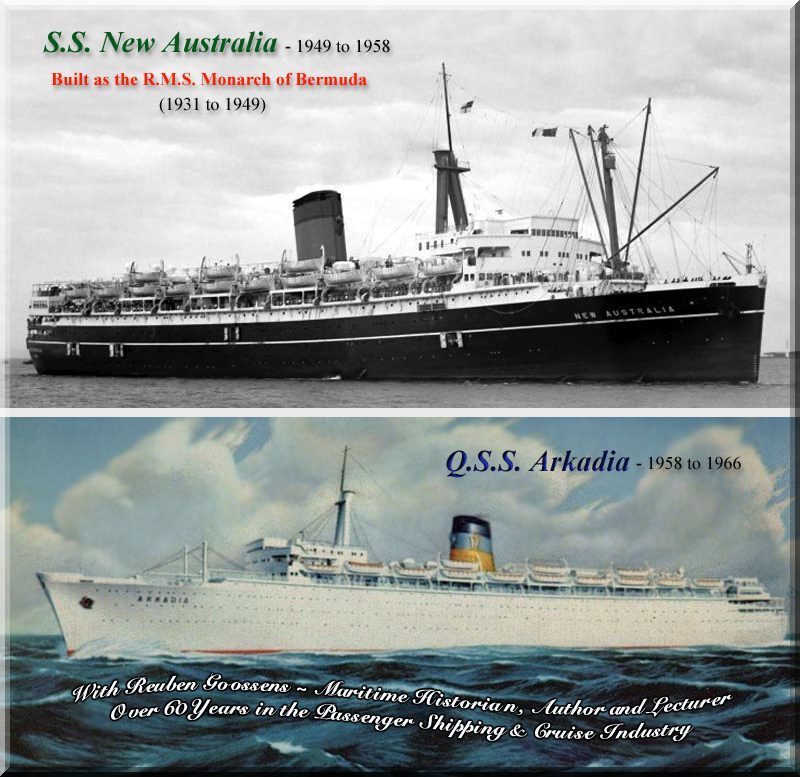
Please Note: Postcards, photographs & other images are either from the author’s private collection, unless stated otherwise.
A special thank to the ssmaritime supporters for their very kind assistance
Page Two
S.S. New Australia & S.S. Arkadia
This feature covers two pages; Page One will
feature this ship as built in 1931, including her days as a troopship. This page, Page Two will cover this ship in
her two final guises; 1. The British migrant liner the S.S. New
Australia of 1949; and the Greek Line’s
S.S. New Australia
After her fire on May 24, 1947 whilst at the “Palmers” shipyard at Hebburn on the River Tyne, where she was to be restored to her luxury liner days, after her years as a troopship, with the damage being severe the owners intended to scrap the “Monarch of Bermuda”.
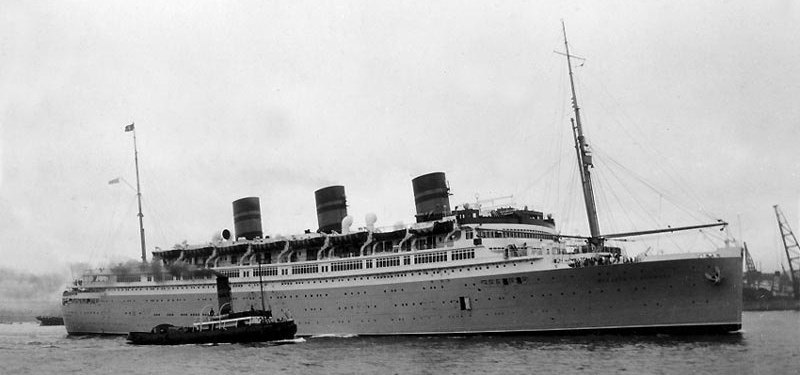
The R.M.S. Monarch
of
Although there was a great shortage of
passenger ships with so many having been lost during WW2, and thankfully the “British
Ministry of Transport” (MoT) decided to purchase this badly
damaged ship, but with her powerful engines being in perfect working order, and
have her rebuilt into a basic emigrant liner for British migrants to head to Australia.
She was moved under her own power to
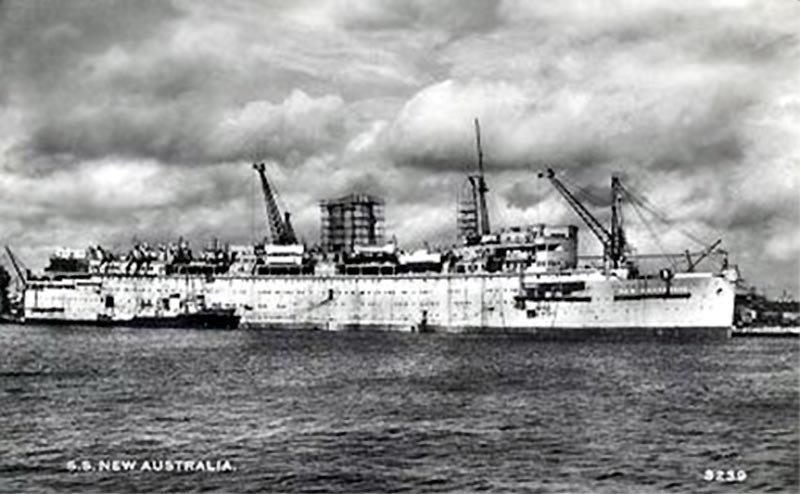
She is seen here
at “
During her rebuild her distinctive three funnels were removed and replaced with a single funnel, as well as an unusual bipod structure just aft of her bridge that served as both a funnel and a mainmast. Accommodation wise, she would now accommodate 1,600 passengers in a One Class configuration. In her new guise she offered some 4 berth cabins, but there were a large number of 6 and 8 berth cabins. Although the grand public facilities had long gone, she had been the ultimate of luxury, but now she only offered the most basic facilities, the only reminder of those past glamorous days were the outdoor swimming pool aft on A Deck and the stunning indoor pool located amidships down on E Deck.
In 1949 MoT renamed her “New
Australia” and they appointed “
Her “Shaw, Savill” livery was as follows; she had a black hull with a thin white ribbon surrounding the hull, her boot topping was red, and she had a white superstructure that was topped by a single yellow and black funnel. Although her bipod mast atop just aft of the Bridge was also a funnel, as well as her main mast, this and her forward mast completer with the traditional lookout were corn coloured.
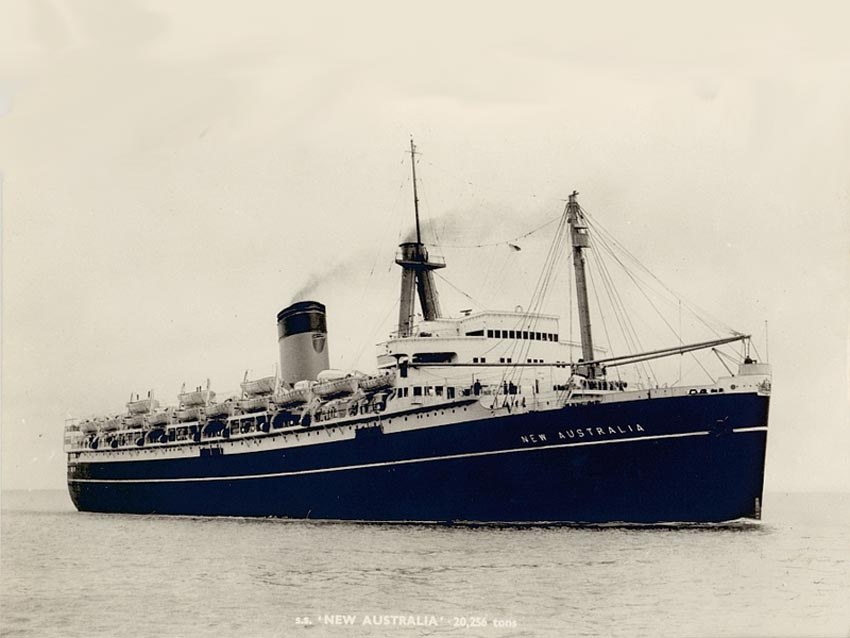
The newly
completed “New Australia” featuring her official “
As I said earlier, the “New
Australia” was rebuilt exclusively to enter the migrant trade,
transporting British emigrants to
Maiden Voyage as the
“New Australia
S.S. New Australia departed Southampton on August 15, 1950, and she
headed via the Suez Canal to Fremantle (West Australia), then continued to
Adelaide (South Australia) arriving in Melbourne (Victoria) on September 15,
1950, and then to Sydney (New South Wales) arriving there on September 18,
1950. During this voyage S.S. New
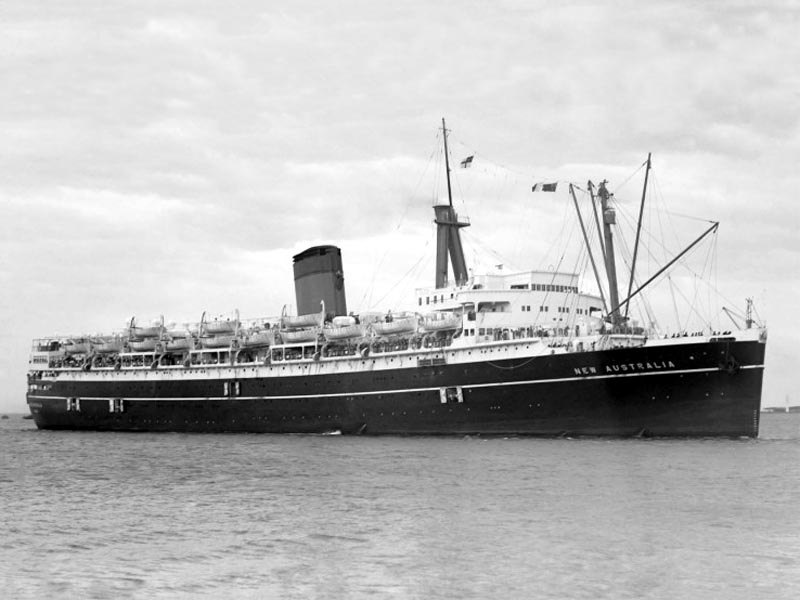
She is seen
arriving in
The Voyage Southampton Sydney
For those sailing on the “New
Australia”, it would only be upon boarding they discovered that families
would be split up, boys would stay with their fathers, and girls and babies
remained with their mothers. Frequently, two families would have to share a
cabin. Although some families would be berthed in one of the two six-berth
cabins onboard, although there were some four-berth cabins and countless
eight-berth cabins. For those berthed up on the poop deck aft, just above the
main passenger decks, the few cabins there generally had good ventilation, and
that was important in the tropical regions, although those accommodated on the
lower decks tended to suffer from the heat when in the tropics.
Children would have to dine at a separate “children’s sitting” whilst the adults
then dined in several sittings. The ship had a number of play areas for the
children and generally the majority of children would play there. They
entertained us with books, stories and games.
On the voyage from
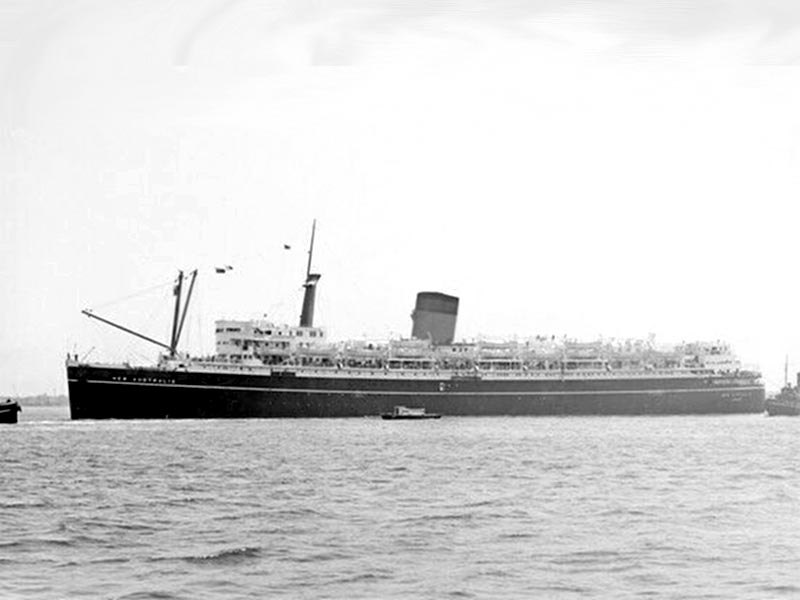
S.S. New
In the Suez Canal, “New Australia”
stopped at
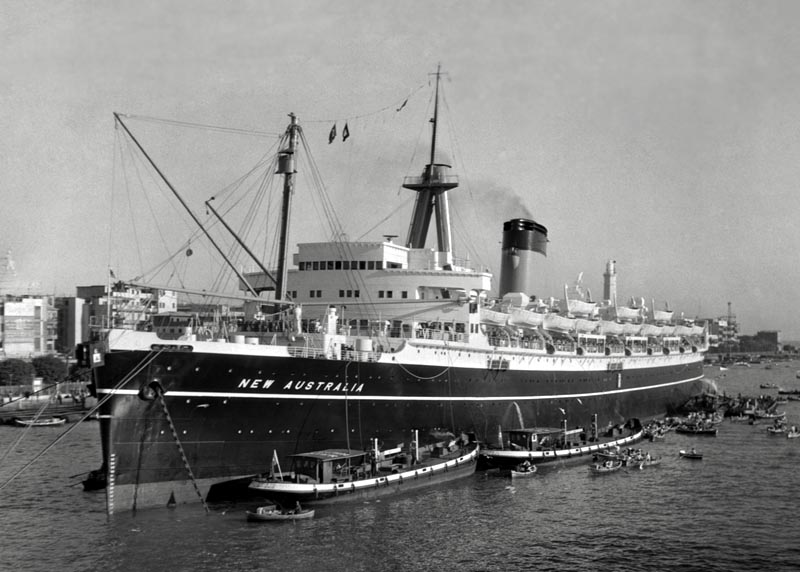
Above &
below: Here she is seen at
and locals in their small boats selling Egyptian souvenirs
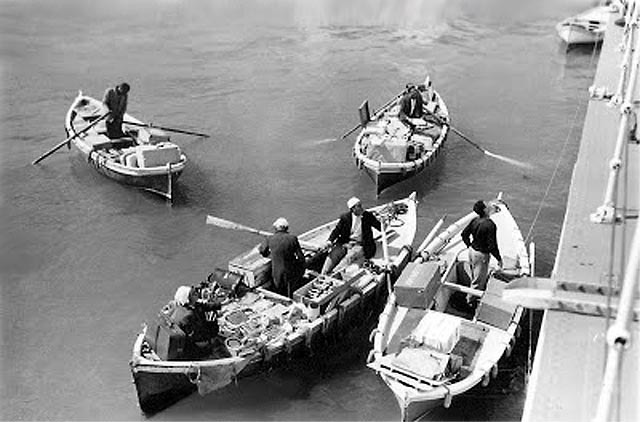
Having reached Red Sea, the ship would head
for the
Then, there was a long voyage across the
Indian Ocean bound for Fremantle,
A Migrant Liner &
Troopship:
Having offloaded all her passengers in
The Australian Government and the Australian Military took over the New Australia for special trooping duties and important role for the Australian military action in the Korean and as well as Malayan conflicts.
In March 1953 the “New Australia”
carried troops of the 2nd Battalion (2 RAR), “The Royal Australian
Regiment” (2RAR). She departed on March, and she headed for
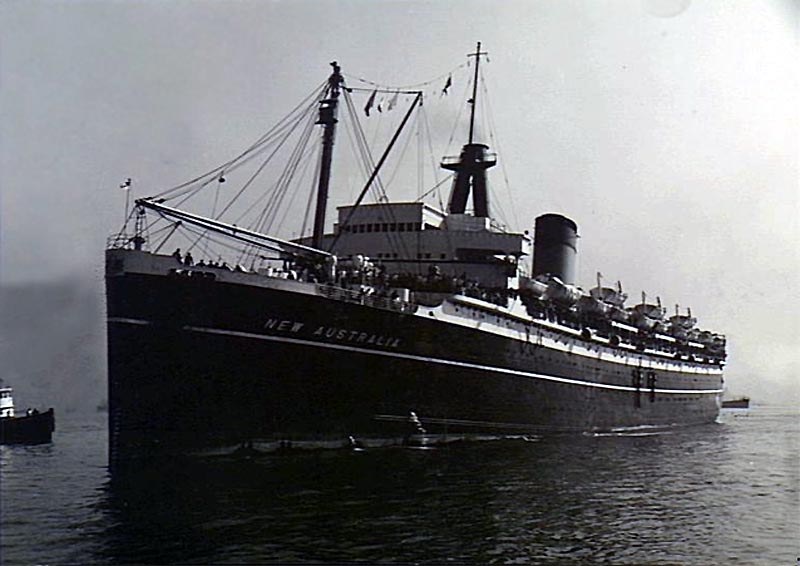
She is seen
pulling into
With the 2nd Battalion having disembarked, but
troops from the 1 Battalion (1 RAR) having completed their Korean duties
embarked the “New Australia” and they headed back to
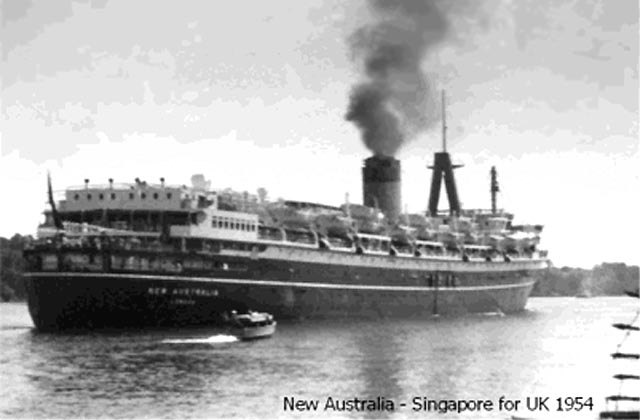
S.S. New
Being back in
Onboard the troopship “New
Australia” was the First Battalion of the “Royal Australian
Regiment”, and she arrived in
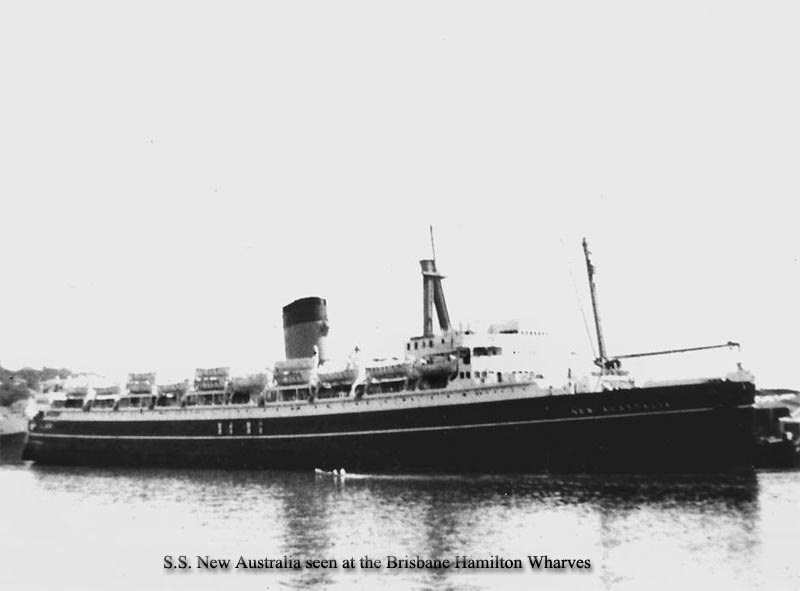
Troopship
“New Australia” is seen in
At an organised march past ceremony to
Brisbane City’s Town Hall, one soldier lead the Battalion’s mascot,
being a Shetland pony. The Prime Minister the Right Honourable Sir.
She departed
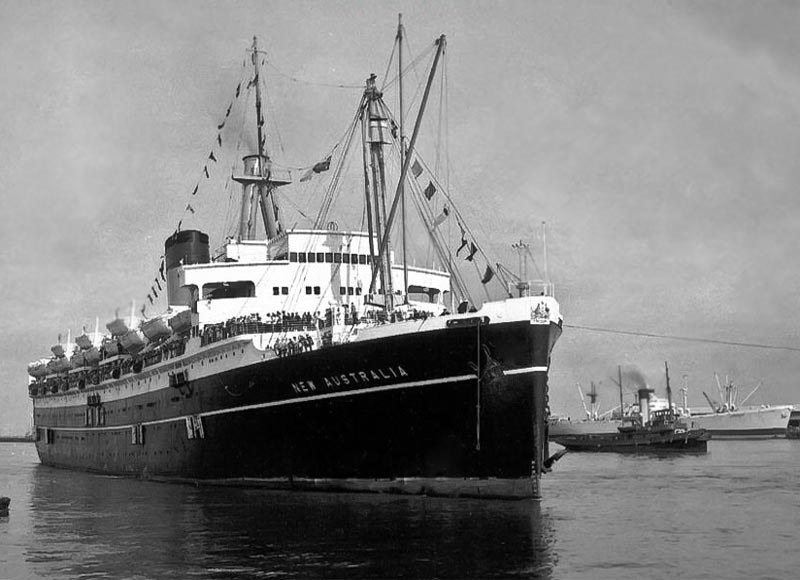
She is seen arriving in an Australian port, with most of her passengers out on deck
Having arrived in
She departed
S.S. New
The above proves that the “New Australia” played an important role for the Australian military action in the Korean and Malayan conflicts.
Collision with the tanker France
However upon returning to
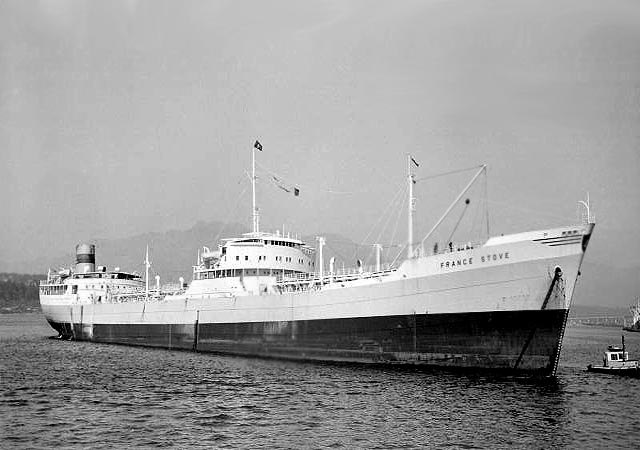
The 16,551 GRT - tanker M.S. France Stove
Thankfully there were no casualties. Although the New Australia sustained damage to her bow, whilst the France Stove was holed on her starboard side and lost her starboard bridge wing and both starboard life boats, and she suffered severe damage, especially to her stern superstructure.
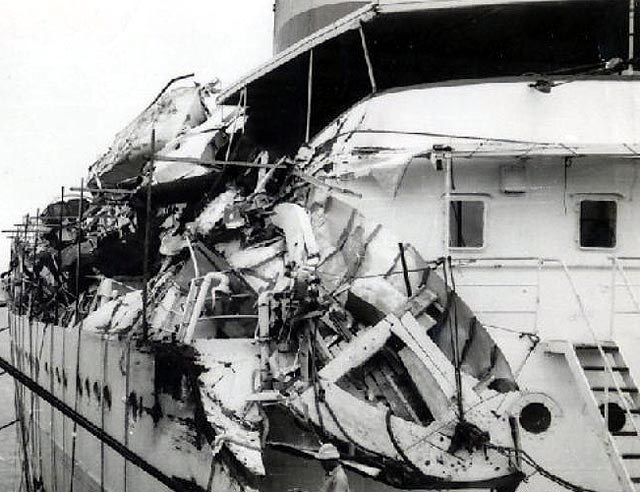
Damage is seen of France Stove’s aft (stern) superstructure
A fire broke out aboard the tanker which spread
to oil on the surface of the sea that had leaked from a ruptured tank. The fire
aboard was rapidly extinguised by the crew and caused little damage. Both ships
had pilots aboard at the time and both remained at the site of the incident for
three days while temporary repairs were made. At the time of the collision the
troopship New Australia was taking troops of the 3rd Battalion of the
Royal Australian Regiment, together with their families, to
This incident had the potential to turn into a disaster of tragic consequences, considering the circumstances and the number of people onboard, but fortunately it wasn’t to be.
At the time, it should be noted that both
ships were under the command of a Pilot at the time and the New
Australia was nearing the northern limits of the Great Barrier Reef Pilotage off
She finally arrived in
New Australia
The “New Australia” had been operating on what was called the “Migrant Charter”. However whilst on her last voyage Down Under, on September 21, 1957 the “Migrant Charter” was officially terminated, being the end of this ships role to Australia!
With her “Migrant Charter”
concluded she was laid up and placed on the market and it was assumed that she
would end up at a breakers yard. However, she was sold to a
Q.S.S. Arkadia
Thus in January 1958, the
S.S. New
They sent her to “Blohm &
Voss” in
Her foremast was replaced with two king-posts, and a new shapely traditional Greek Line funnel, being yellow, blue and black top, with the company’s golden logo in the centre. As her forepeak had been damaged in the collision in September 1957, it was remodelled to give her a stylish new curved stem, increasing her length to 590 ft - 180 m. Air-conditioning was installed in her Dining Rooms and her other Public Venues, and she was fitted to carry 150 passengers in 1st class and 1,150 in tourist class, and when completed she was a more modern looking ship having been painted all white.
Greek Line renamed the now 20,256 GRT
ship (Quadruple
Screw Steamer)
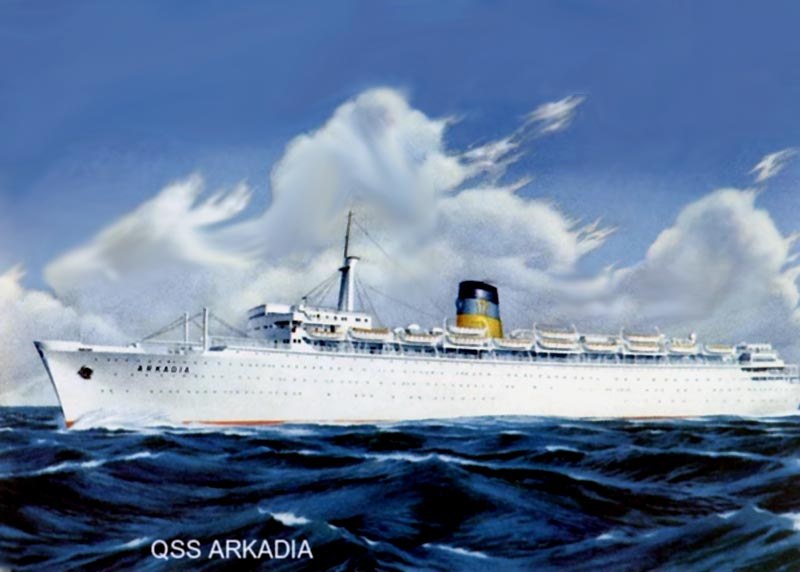
An early release
postcard of the
Finally on May 22, 1958,
the Arkadia departed on her first voyage from
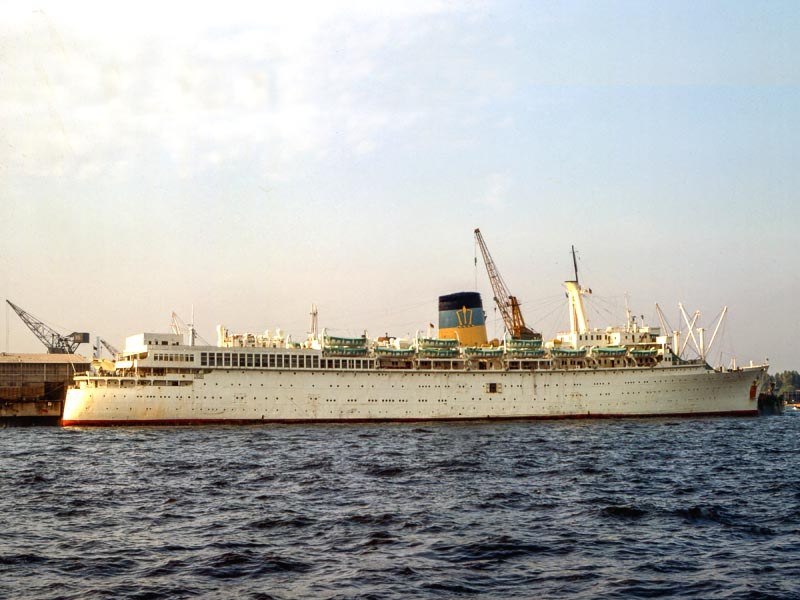
She is seen here in port
On June 17, 1958, she commenced her first
voyage from
In 1959 the “Arkadia” did operated
some cruises from
It was decided in 1961, to give the
“Arkadia” a further refit at the “Blohm & Voss”
yard in
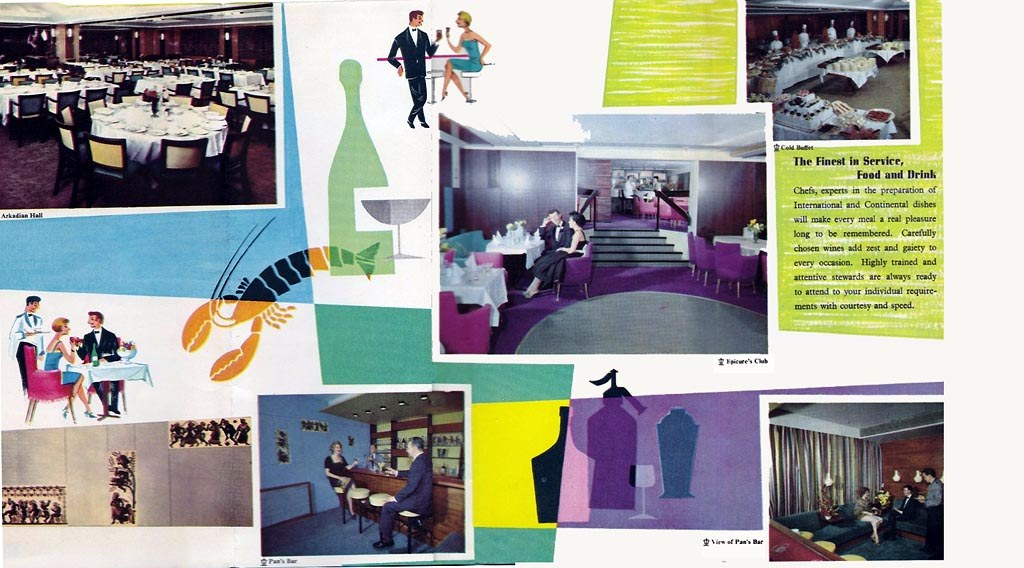
Here is part of a
post 1961 brochure, revealing her attractive interiors
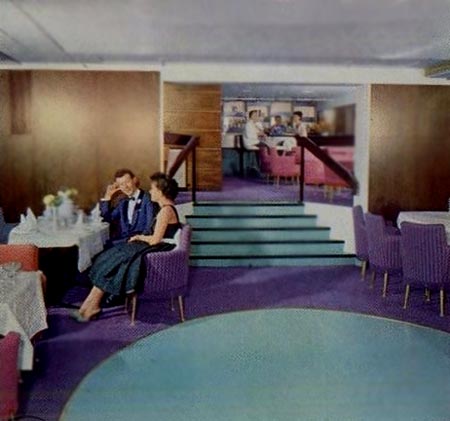
A better photo of the First Class Restaurant
The “Arkadia” continued her Trans-Atlantic services as well as her popular cruises.
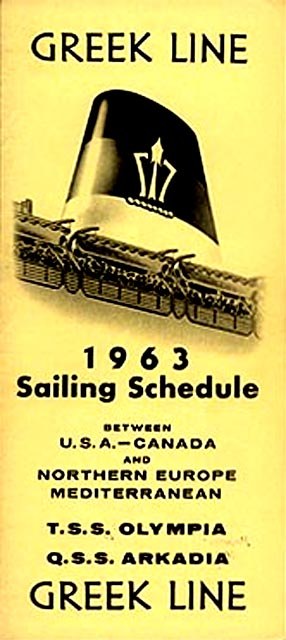
But on October 23, 1963 she departed
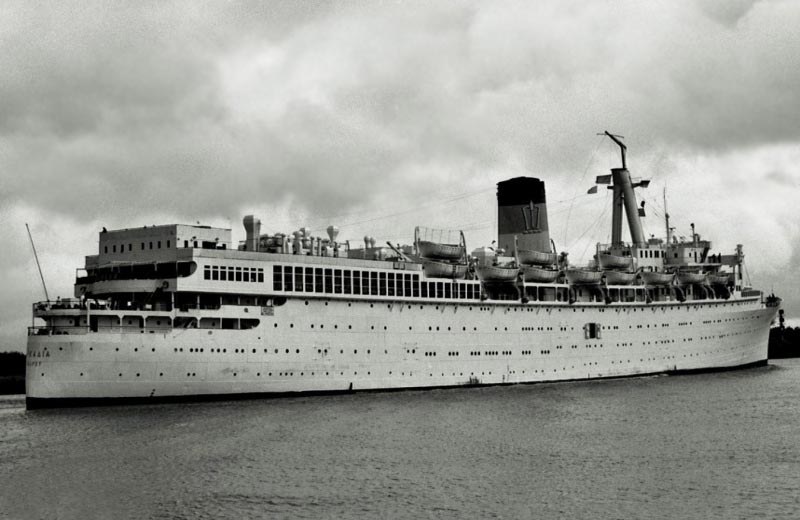
This Cruiser Stern
shot was taken during her last visit to
The Greek Line’s T.S.M.S. Lakonia
On December 19, 1963, this now elderly ship
which less than a year earlier she had been the popular and very reliable Dutch
liner the
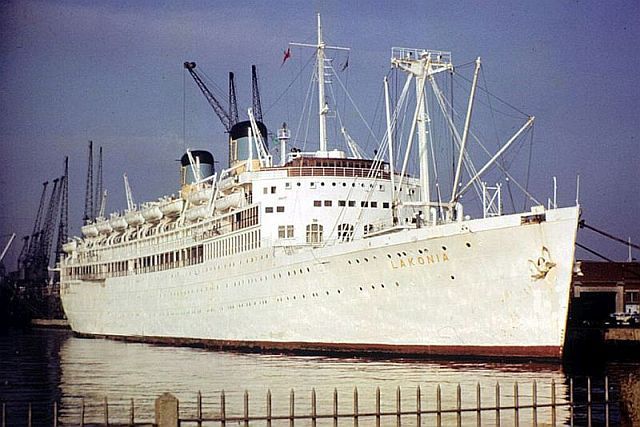
The
ready for her 11-day “Christmas Cruise” on December 19, 1963
Onboard were 1,022 persons, being 646
passengers and 376 crew, all ready to serve these happy
vacationer’s. Commanding the “Lakonia” was
On December 22, at around 11 pm, a steward noticed thick smoke seeping under the door of the ship's hairdressing salon. Upon opening the door, he found the room completely ablaze, and the fire rushed into the hallway toward the state rooms. He and another steward tried to fight the flames with fire extinguishers, but the fire spread too fast to be contained.
Due to the severity of the fire, the Captain ordered “abandon ship” and many took to the very poor lifeboats. When all of the usable lifeboats were away, there were still people in the water and at least 100 people remained on the burning ship. The “Lakonia” continued to burn fiercely and she was rocked by violent explosions. Those who remained aboard flocked to the glass-enclosed “Agora Shopping Centre” located on Promenade Deck at the very stern section of the ship. After several hours, the flames closed in on them, and they were forced to descend ropes and rope ladders into the ocean. All the port and starboard gangways had been lowered and people walked down the gangways single file and jumped into the sea.
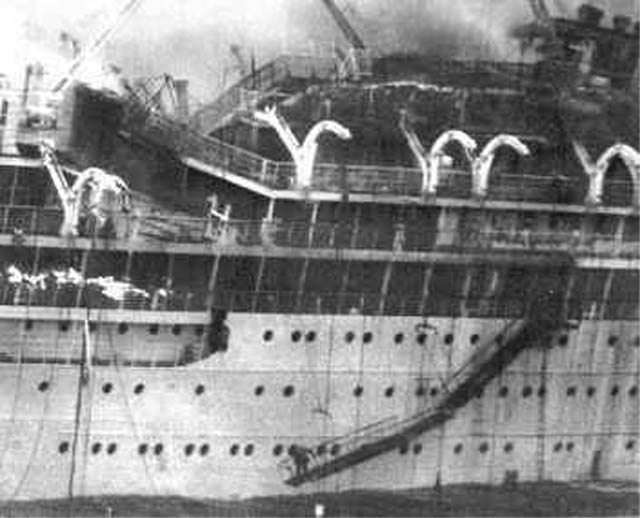
Passengers are still onboard and we see a man on the gangway
When the “Arkadia” returned to the
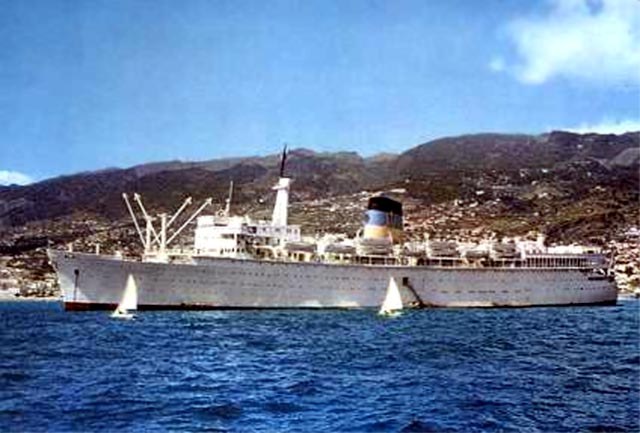
Arkadia seen as a
fulltime
The Ships Final Days:
Then on August 16, 1966 the
Then on November 21, 1966, the
“Arkadia” was laid up in the River Fal,
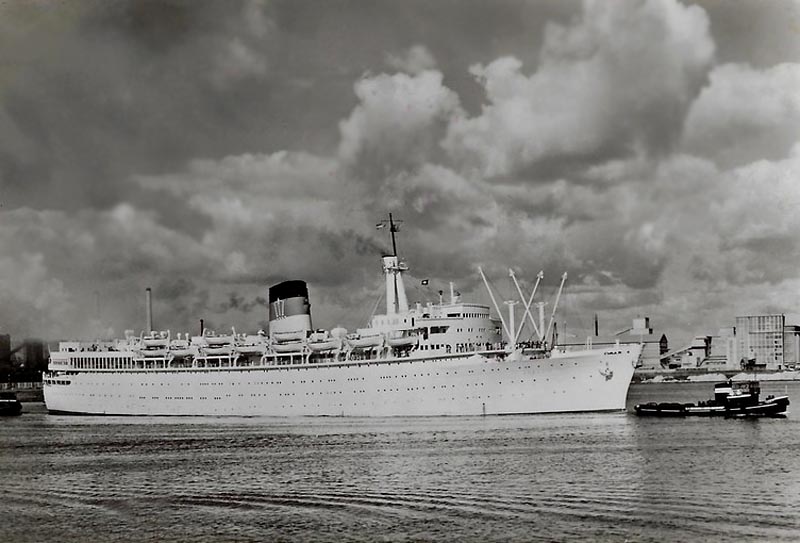
I will close with
one of the best angles of the
**************
“Blue Water
Liners sailing to the distant shores.
I watched them come, I watched
them go and I watched them die.”
Featuring over 1,362 Classic Passenger Liners, Passenger-Cargo Liners & Classic Cruise Ships!
Or ENTER HERE
For interest: Sadly an email service to ssMaritime is no
longer available, due to the author’s old age and chronic illness as well
as being disabled, etc. In the past ssMaritime received well over 120 emails
per day, but
**************
ssMaritime.com & ssMaritime.net
The Author has been in Passenger Shipping & the Cruise Industry for well over 60 years
In addition he was the founder of “Save the Classic Liners Campaign” in 1990.
Please Note: ssmaritime and associated sites are 100% non-commercial and the
author seeks no funding or favours of any
shape or form, never have and never will!
Photographs on ssmaritime and associate pages are by; the author or from the author’s private collection. In
addition there are some images that have been provided by Shipping Companies
and private photographers or collectors. Credit is given to all contributors.
However, there are some photographs provided to me without details regarding
the photographer/owner concerned.
This notice covers all pages; although, and I have done my best to ensure that all photographs
are duly credited and that this notice is displaced on each page, that is, when
a page is updated!
ssMaritime is owned
& © Copyright by

